Fly Fishing In Scotland
December 11, 2020



 Fishing,SCA Articles
Fishing,SCA Articles
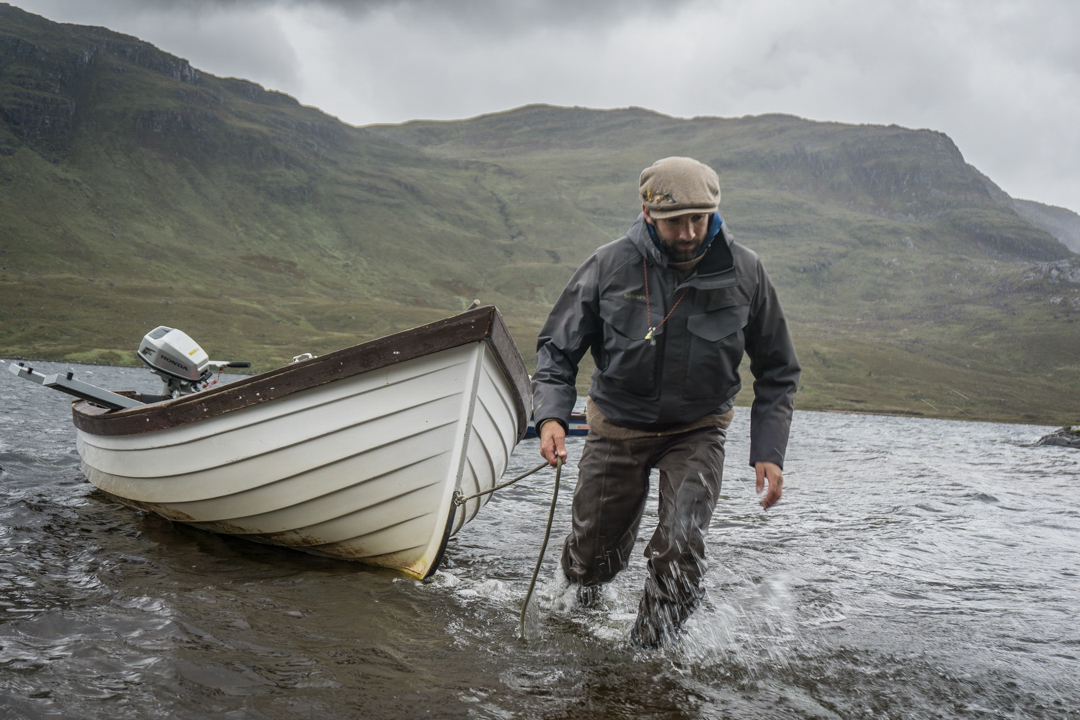
Fly fishing in Scotland isn’t just a caricature of a bygone era. It offers modern fly fishing experiences equivalent to the very best international lodges, while also offering heritage and culture.
“It’s a long line of whispers that gets you on Loch Damph,” says Corin Smith behind the wheel of his pickup. We’re heading to the lake, its reddish-black water held within the bounds of a private estate like a cup of choppy tea between mossy, wind-swept mountains. One is free to walk across any parcel of soil in Scotland, private or no, but fly fishing requires permission. And don’t think for a minute the man holding the key is an easy one to pin down.
Fortunately, Corin, owner of The Wild Rise Company, knows the gatekeeper. In spite of the long-established system within which he operates, Corin’s approach bends tradition. Beyond tropes of tartan and tweed, fly fishing in Scotland today toes a line somewhere between old and new, like a well-worn book that just needs dusting off and, perhaps, a new chapter.
We wind along a one-lane road cutting through the subarctic moor of the Northwest Highlands, where the eldest hills in the world—3.1 billion years old—rise green and gun-metal gray from purple heather. This is a place quasi-inhabited, a place where it’s unclear if behind white-washed cottage walls there is anyone under the age of 60 stirring within, the young people having fled to work on oil rigs.
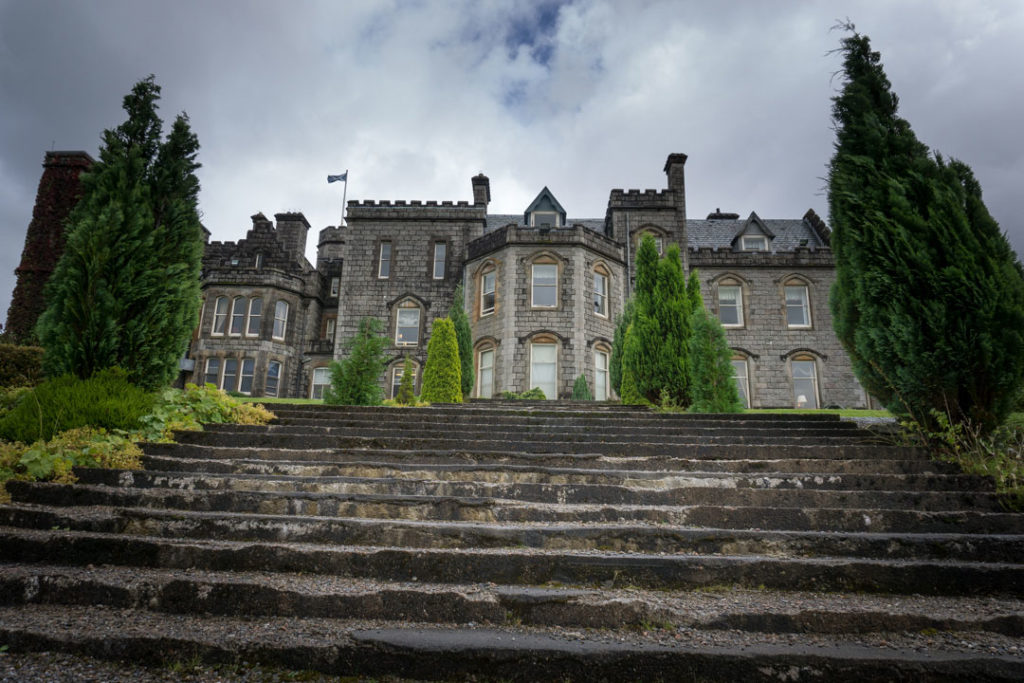
Sheep with blue brands slashed on bone-white flanks loiter along the road. Sea lochs speckled with fishing villages carve steadfastly inland like arrows from the storm-lashed coast, stopping just short of the country’s heart. The air alternates damp or windy, always carrying some watery pheromone, whether salty or clear. Vikings may land at any moment.
The moors are to the Scottish psyche what the biggest forests or sparest deserts are to the North American mind—equally majestic and terrifying, filled with howling winds, shifting mists, Neolithic stone structures, and thousands of lakes and rivers filled with truly wild brown trout and Atlantic salmon. And we hope to try our hand at each.
“Fly fishing connects you with the place in a way few things do. You’re a tourist, but connecting in a deep way,” says Corin as we pass centuries-old stone fences that climb impossibly steep mountainside pastures.
“With most tourism, it’s external—you’re standing and looking at something. With fly fishing, you’re immersed. That’s one of the most extraordinary things about it.”
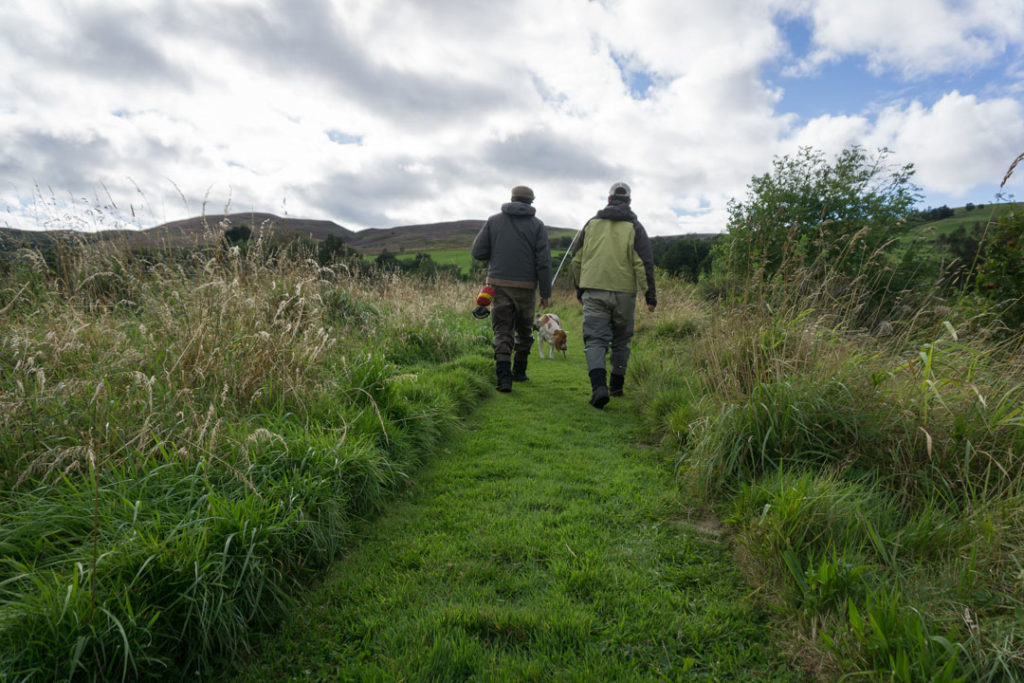
Scotland, the homeland of fly fishing, was long the darling of angling travel for Americans, offering an easy and somewhat familiar destination. But several factors pushed it down the totem pole. First, the introduction of commercial salmon farms adversely impacted wild runs of Atlantic salmon and sea trout in much the same way that fish farms, hatcheries, and dams have decimated anadromous species in the U.S.
Second, with the 21st century development of destination fisheries in the American West, Patagonia, the Caribbean, Central America, and other locales boasting monster fish of all breeds, Scotland quietly took a backseat, carrying on its ancient traditions whether the world noticed or not.
But Scotland seems to be creeping back. The popularity of shows like Outlander have enticed travelers to return. And there are still plenty of curious anglers and wild Atlantic salmon to be found, driving a growing £130 million angling industry. For decades American sporting writers generously covered the heritage and charms of Scottish angling, but the story has changed as much as the fishery, and, in other ways, remained the same.
Mind you, we spent several glorious days in Fort William prior to fishing, indulging our Yank urge for kitsch and cliché. We sampled single malts, played golf, attended a cèilidh party (complete with bagpipes), and stocked up on woolen goods. But Corin aims for a dimension of technical training and cultural immersion beyond Braveheart quotes.
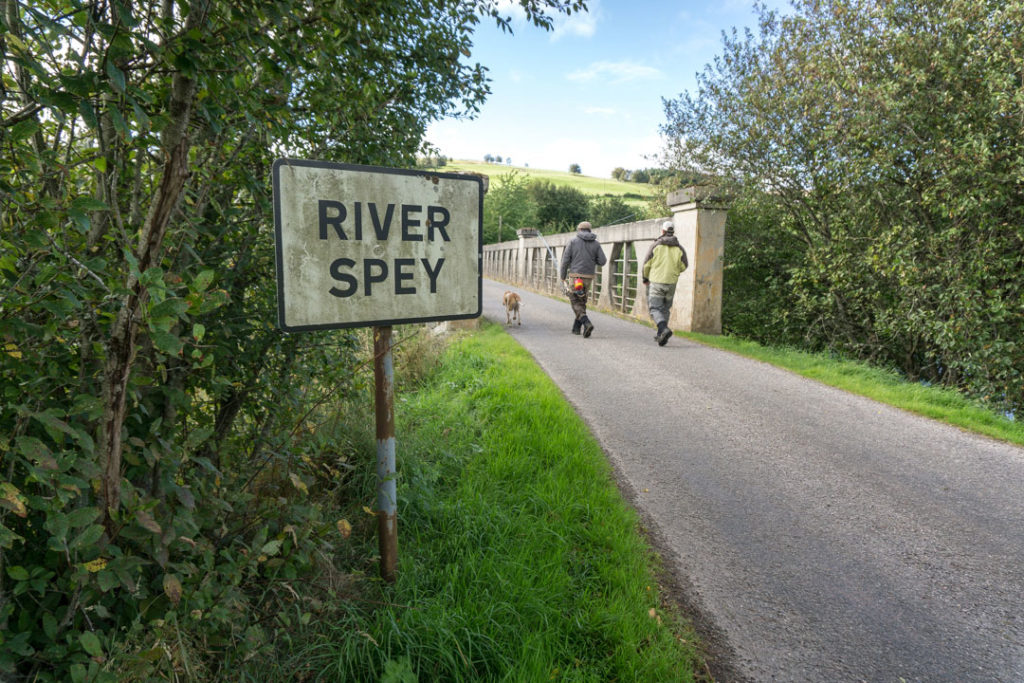
Here in the northern reaches, not much has changed since the days of Queen Victoria, when English industrialists bought up massive swathes of hills and valleys for holiday shooting and fishing. Just about every empty mountain, gorge, and stretch of rolling moor the eye can see is privately owned by some person in some place other than right here. While the English developed the formal trappings of Victorian sporting culture, Scots are saltier folk with their own quirks and charms, and the way they fish shows it.
“We don’t have the pretension here. You don’t have to wear a tie or any of that bollocks,” quips Corin.
Traditionally, estates with lochs or stretches of river hired a ghillie, who looked after the boats and kept an eye on the fishery, guiding the estate owner during a stay. Ghillies often served for decades on a single estate. Scottish ghillies dress less formally than English anglers, but many still adhere to a certain tweed standard.
Corin is both a guide and outfitter. He’s explored a variety of fisheries, secured access to them, and now takes clients to whichever place is fishing best according to the time of year. It’s an unusual approach here, where sporting tradition is tradition.
“My definition of a fly fishing guide is someone who goes out into a blank canvas of a fishery,” Corin says. “You’ve got the freedom to go where you want, and you have to figure it out to put your clients in the best location.”
He plays house music in his rig and sometimes shows up barefoot or in flip flops to the River Spey. “Sleep in your truck again?” the ghillies inquire.
His philosophy is a reflection of his own trajectory. Raised on a Highland sheep farm, swept up in a corporate career that took him from the pastoral greenery of Perthshire to London and then to Asia and Australia, he burned out by age 30 and reinvented himself through what he loved most: fly fishing. He became a guide in the far-flung Seychelles under the tutelage of South African angling legend Arno Matthee. In 2009 he returned home and decided he’d do fly fishing his way, as an outfitter, whether it followed rigorous convention or not.
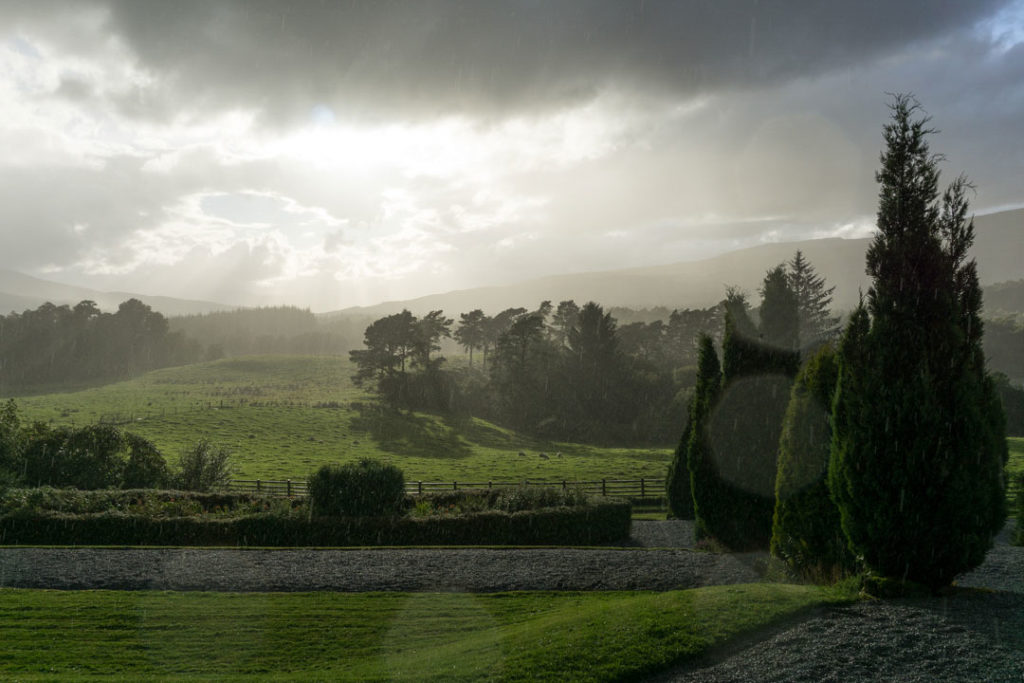
Now, at 40, he’s combined all he learned as an international guide with the seasonal patterns of local rivers and quirks of Scottish fishing-access laws, in which salmon and trout rights are privately held. These regulations make it tough for a thriving outfitting industry to form but have also kept rampant commercialization at bay. You’ll never run into ten other boats or be packed shoulder to shoulder on a wading stretch, especially on the lochs. The epic scenery is, for the most part, as lonely as the wind.
We arrive to the northeast shore of Loch Damph and load into the boat. Corin starts the motor and putters across the chop. The rowboats used for loch fishing little resemble the pimped-out drift boats of the American West or the sleek saltwater skiffs of the Florida Keys. These fiberglass rowboats are intended for the big, open water found in Ireland and Scotland, sitting low and stable in the waves. Plain wooden slats for seats. No fancy compartments for stowage. A motor, oars, and a bailing bucket are the primary accessories. Scots keep it simple across the board when it comes to fishing. You’ll not see fancy coolers or piles of gear. A few bottles of water are all we’ve brought to hold us until lunch.
“I’m always thinking about how to have less gear,” says Corin. “You don’t need ten spools of tippet. Focus on the fishing, not spending endless hours looking for your gear. The more gear you have, the more your head gets scattered around.”

The approach to covering water here is simple: start on one end and allow the wind—and there will be wind—to push the boat the length of the loch. The guide will row into place, hugging the seam where the shore tapers into a steep shelf drop-off.
“The ghillies used to keep a boat on each end of the loch. They’d ride a pony to the end with the boat, jump in, and then drift back to where they started,” Corin relates, settling onto the center thwart and running the oars through the rowlocks. “They’d use a pony to drag the boat back to the beginning end while the guests had elevenses. It was pretty genteel back in those days.”
The approach to loch fishing is quite unique and technical, developed over hundreds of years. Scots, renowned for their exquisite contributions to fly design, rig up with a “cast of flies.” Three flies are tied to the leader—a point fly at the end and two droppers tied on at eight-inch intervals, hanging from about four inches of tippet. When this formidable Cat o’ Three Tails catches the wind and gnarls into an orgy of flies, you have not a tangle on your hands, but rather a “fankle,” which sounds like a fated meeting of “f–ck” and “cankle.” A fitting word for this unfortunate circumstance.
Combined with the trio of flies, an angler has to understand how to use the wind to his or her advantage. A healthy gust to create surface chop is preferable, which means roll casting a lot and false casting as little as possible.
“It’s quite benign today,” notes Corin as the wind whips our lines across the water and stray hairs batter my sunglasses.
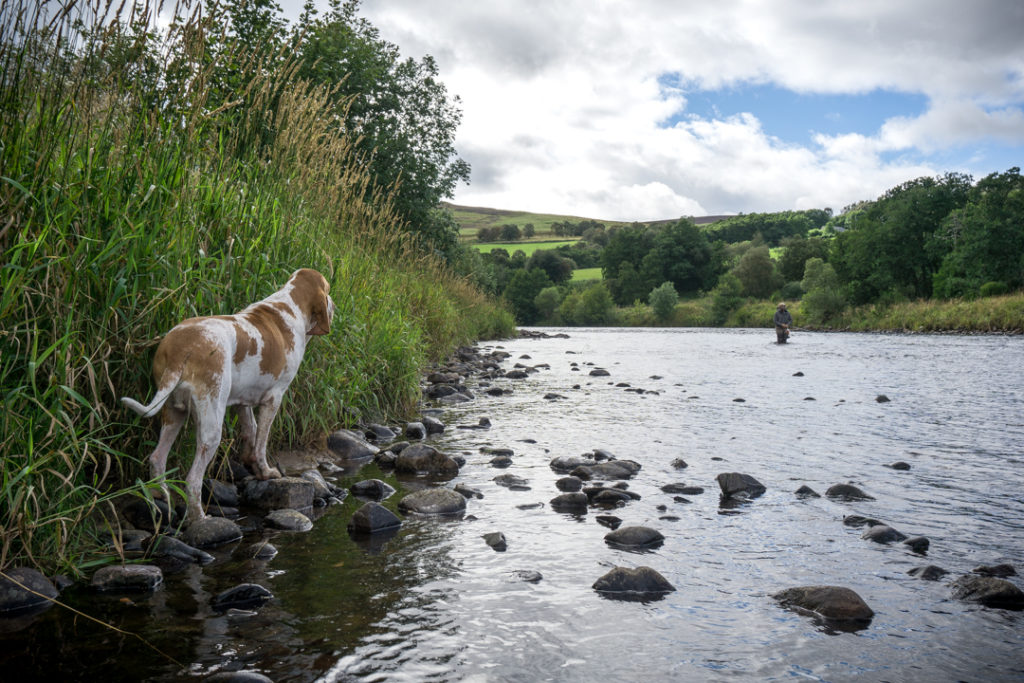
I have my first brush with the Dreaded F early in the game, barely lifting my flies from the water to ensure they aren’t fouled. A roaring gale catches the first two droppers, then lifts the third from the water. I attempt to conceal and work out the monofilament nest in the back of the boat, but much like their American counterparts, you can’t hide much from a good Scottish guide.
“I appreciate the optimism back there, but just cut them off,” Corin instructs. He ties on new droppers in moments, like a spider weaving a web.
The weather is predictably moody, flowing through an endless cycle: clouds creeping in, light and pelting rain, sun and wind. It all forms a tightly orchestrated system, the metronome of roll cast and strip, roll cast and strip, the dip of the oars, consistent no matter what the sky throws down on your small boat drifting between towering mountains. Every ounce of harshness is matched with beauty in equal measure.
You can’t swing a dead cat without hitting a body of freshwater holding brown trout in Scotland. The season begins in mid-March and ends in early October. By the afternoon we’ve each caught and released a handful of brownies, which take the flies wobbling below the frothy crests.
I miss the take on my first fish, mistaking it for rigorous chop or the loch bottom, but the rod bends and I reel in with soaked fingers. The trout emerges kicking from the inky water, a dull mustard-gold with blood-red spots, and Corin nets my catch, holding it up for me to examine. The brown trout in these high lochs are distinct, living in incredibly harsh conditions with a meager food base. They are thinner and scrappier than their sometimes-corpulent cousins transplanted across the ocean, every centimeter of growth a small battle won.
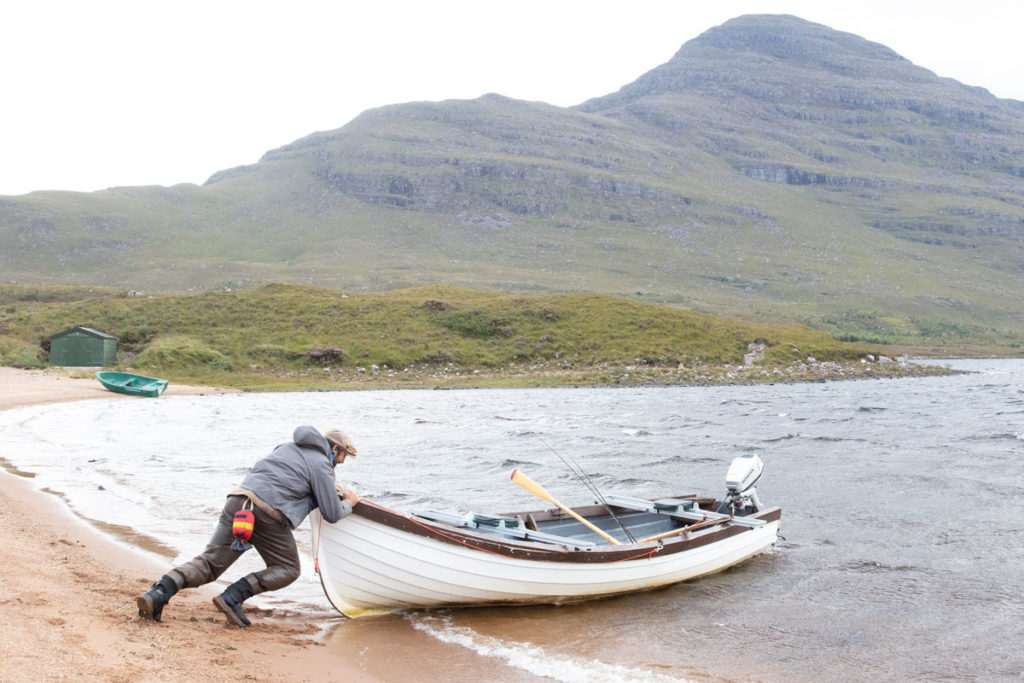
“Unlike most destination trout fisheries, these fish are wild in every sense of word,” says Corin.
To bring a brown trout to hand is to reel in some serious history. These are truly endemic fish, enduring since the last ice age, arriving via migration through ice lakes and other routes. Having made it 10,000 years, loch trout are hardy, highly adaptable, and, in some cases, living up to ten years. Because they live in such isolated populations, brown trout in some lakes are genetically distinct from other stocks, making them a national treasure.
Anglers may catch up to 20 fish in a day, depending on the weather and time of year. For those concerned with fish size, there are monster brown trout to be found in the lake, to be certain. Don’t expect one every other cast, but they’re in there. And if you cast where told, you might hook into one. There are also sea trout and ferox trout—a piscivorous variety of brown trout—to be caught. We manage to haul out and release a few of each.
I glance over whilst stripping in line to see Corin dip the bailing bucket into the tannin loch. He drinks from it.
“I’ve never seen anything like that in my life,” I observe.
“What?” he asks, tipping back the bucket.
“No ‘Beaver Fever’? No parasites?”
“I drink it all the time. It’s good, clean water.”
While the water is apparently clean enough to drink, the broader environs of Loch Damph reveal an ecological tale common to most of the country. As we drive to the lake each morning, we pass evidence of an evolving landscape.
The proper Scottish sheep, the blackface, has been supplanted in many places by chiveats—smaller, hardier buggers from the Lowlands with impressive reproductive rates and greater yields of meat and wool. Native Caledonian forest once covered much of the land but was chopped down long ago and further crushed by an explosion of red deer. The deer run rampant due to lack of apex predators. A stone on the outskirts of the village of Killiecrankie marks the fateful spot where the last wolf in Scotland was slain in 1680.
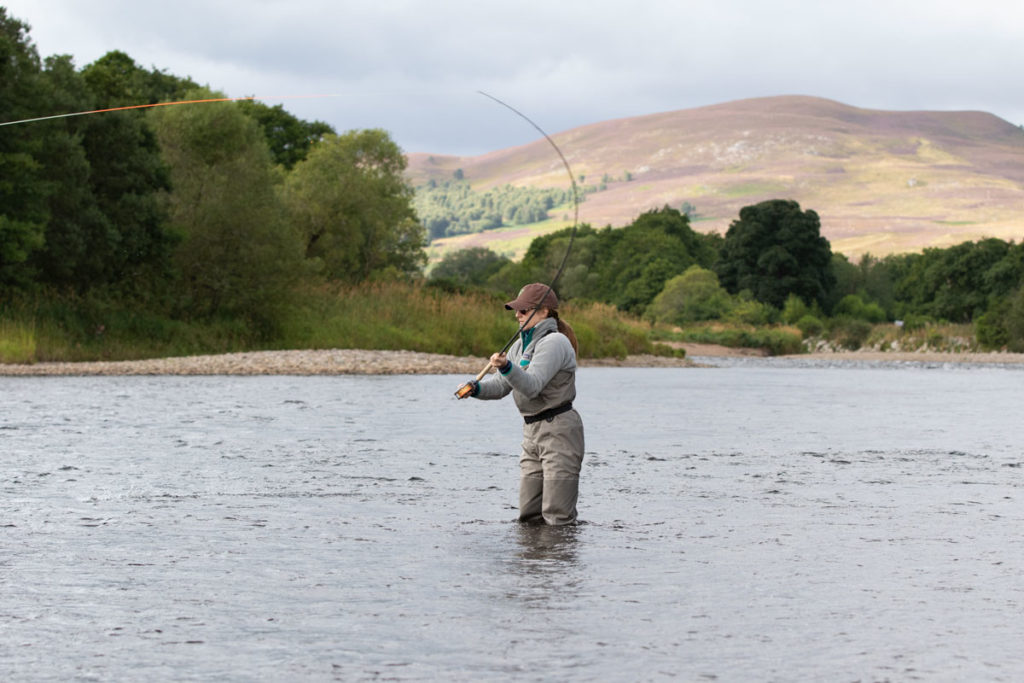
Corin recognizes contemporary truths and points them out along the way, refusing to let visitors walk away blissfully duped by the charm of a sheep flock blocking the road or endless hills of green. At the core of his passion for guiding is a desire to educate anglers on the historic and present fishery, and where it might go in the future.
In many coastal regions, the once epic runs of wild Atlantic salmon and sea trout are deleteriously impacted by lice-infested salmon aquaculture operations, introduced to sea lochs in the 1970s. Sea lochs are long, narrow ocean arms that reach inland and meet with rivers, the capillaries to which anadromous fish return each year to spawn. Scotland’s edges are a fringe of sea lochs. Where salmon aquaculture has been completely contained or moved onto land, wild salmon and sea trout populations have recovered. Here on the Northwest coast, aquaculture persists, and as a primary employer in this sparsely populated region, it can’t merely be reformed or removed overnight, in spite of pressure from the European Union.
“There’s no reason other than salmon farms that the rivers and lochs of the Northwest aren’t really good spots for fishing for salmon and sea trout,” Corin explains. “That’s what I want to see restored on this coast. The only way to accomplish that is to make anglers aware, prove to politicians that the economics of a recreational fishery make just as much sense as salmon farms. All of our guide fees go to Salmon and Trout Conservation Scotland, an incredibly unsexy charity which fights for wild fisheries.”
There are still excellent runs of salmon in other locales. We seek to find them. After a few days on Ol’ Damph, we roll southeast to the foot of the Highlands to try our hand at Atlantic salmon on the famed River Spey. Razor mountain edges and the snarl of heather soften out here, giving way to lusciously grassy foothills woven with some of the most famous salmon rivers in the world.
The epic spring run of big, fresh salmon—rarely under ten pounds and sometimes over 30—takes place in April and May. We’re here in September, spawning time, making it tricky to land a salmon.
“The salmon fishing in Scotland is genuinely world class,” says Corin. “On some of the rivers, you might catch twenty fish between a few anglers during certain times. You might not have a twenty-fish day on the Spey, but it’s a consistent river. You’re going to catch a salmon if you put in the work. We’re a bit in a halfway house today. If we were to get a flush of water, a small summer flood, that would move the fish around.”
When the river starts to fall away again, the fish find their spots and aggressively take flies. That’s when good salmon fishing occurs. And even then, much like steelheading, plan on fishing for a week. We’ve got a single day booked to land “The Fish of 1,000 Casts.” We’re going to at least give it a try. And, as we will be fishing on the River Spey, we’ll use Spey rods for two-handed casting.
Fifty years ago you couldn’t access the Spey unless you were the king, literally. It was King Edward VIII’s favorite fishing ground, and we pass his warming hut along the way to Tulchan Sporting Estate, a 26,000-acre spread that hosts limited numbers of guests each year. Here, the water is divided into beats, to which anglers are assigned. We have a prompt reservation at 9 a.m. to fish C. Beat.
“You know you’re going to fish in a specific mile and a half. And these rivers have been fished for centuries. The salmon are in the same place, sitting behind the same stones for two hundred years,” Corin explains. “Hence, this isn’t so much about guiding as it is about hosting you for the afternoon and teaching Spey casting.”
We meet with Lawrence DeRosa, a ghillie with 32 years of experience, 18 of those at Tulchan. If Corin represents an emerging angling culture, Lawrence represents custom.
“How’s your score this year, Lawrence?” Corin asks as we hop out. Lawrence is wearing “plus fours,” the traditional tweed pants worn by ghillies which hang four inches below the knee.
The ghillie’s role has changed over the years, but much remains the same. Part of Lawrence’s job is to manage guests’ days on the river and maintain the grounds along the water. He accompanies us along mowed paths to C. Beat on the River Spey, where fat Atlantic salmon breach in gleeful belly flops from bank to bank. Their airborne sides give away their breeding status, the hens’ flanks having turned from spring-silver to red-brown, and the hook-jawed males displaying bright tartan fighting shades.
Lawrence directs: “That quieter water, there. Get the fly just coming out a couple of meters from the boils, not quite to the tail. We’ve been so low and clear, the temptation is to creep out and creep out, but you’re not doing yourself any favors. They’ll see you.”
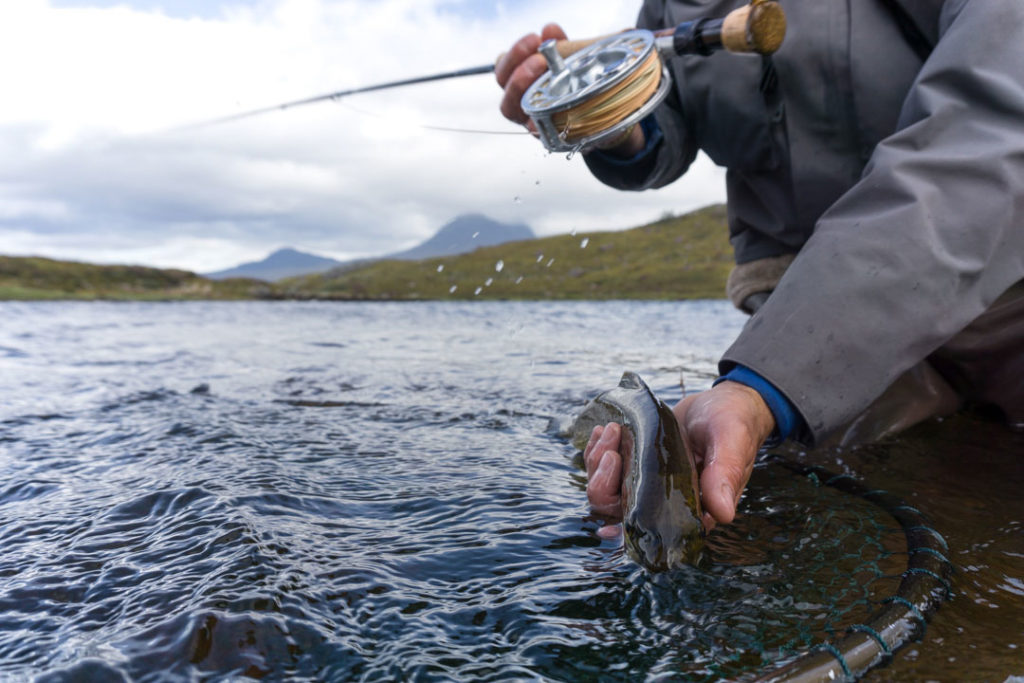
I ask him how long it takes him to mow the endless ribbons of walking paths that line the river. Compared to the gnarl of sagebrush and tall grasses that I’m accustomed to, the mowed paths practically invite skipping, something I never thought possible in wading boots.
“I’ve got it down to about four hours with the tractor. That’s driving like a Formula One racer,” he says with a grin.
The Spey runs clear, lined with slick, round stones. It’s a tough river to wade without studs in your boots, but with the lure of salmon, the temptation to creep out certainly sets in. As a novice Spey caster, I thought I would “get a hand up,” so to speak, by asking an experienced two-handed angler for a lesson prior to Scotland. Proud of my small progressions, I decided to unveil all I had learned here on the Holiest of Holy Spey-Casting Rivers, the River Spey.
Standing on river left, I got into position, left hand on the butt of the rod, right hand above. I let the current carry my line taut and prepared to form an anchor.
“What’s this cack-handed nonsense?” Corin asked before I could even lift the rod.
“I’m going to attempt a Double Spey,” I defended.
“Not like that you aren’t.”
Sent back to Square One, I spent the bulk of the morning learning a proper Scottish two-handed cast—with the left hand above, right hand below when standing on river left, and vice versa on river right.
Rules for salmon fishing are drawn hard and fast. You’re not allowed to fish for salmon on a Sunday. Anglers may not kill hen fish. If you kill a cock fish, it should be a table fish for eating, and a big one at that. And you must break for lunch. When the ghillie takes a lunch break, everyone fishing on the estate takes a break.
“The idea here is not to fish as hard as you can. It goes back to tradition. It would be ungentlemanly to put in too much effort,” says Corin. “Flogging the water as hard as you can is not what we do. We rest the pools. Besides, normally you would be here a week. That’s plenty of time to fish.”
After a morning of casting without landing a fish, but with what I would like to think was vast improvement to my Spey cast, we dutifully take our mandatory break.
“This is like taking you to a fried-chicken joint,” says Corin.
It’s a small bakery in a nearby town, clean and small with a variety of meat pies as the primary offering. I’ve heard nothing but horror stories about Scottish cuisine for years, often summarized as an offering of fried candy bars and gag-inducing haggis. But I’m surprised that, meal after meal, I love everything on my plate, from the simple servings of succulent garlic-butter scallops to cooked peas to sticky toffee pudding. The serving sizes are rational and the presentation simple. We order Scotch pie—a meat-filled pastry—and tea. Always tea.
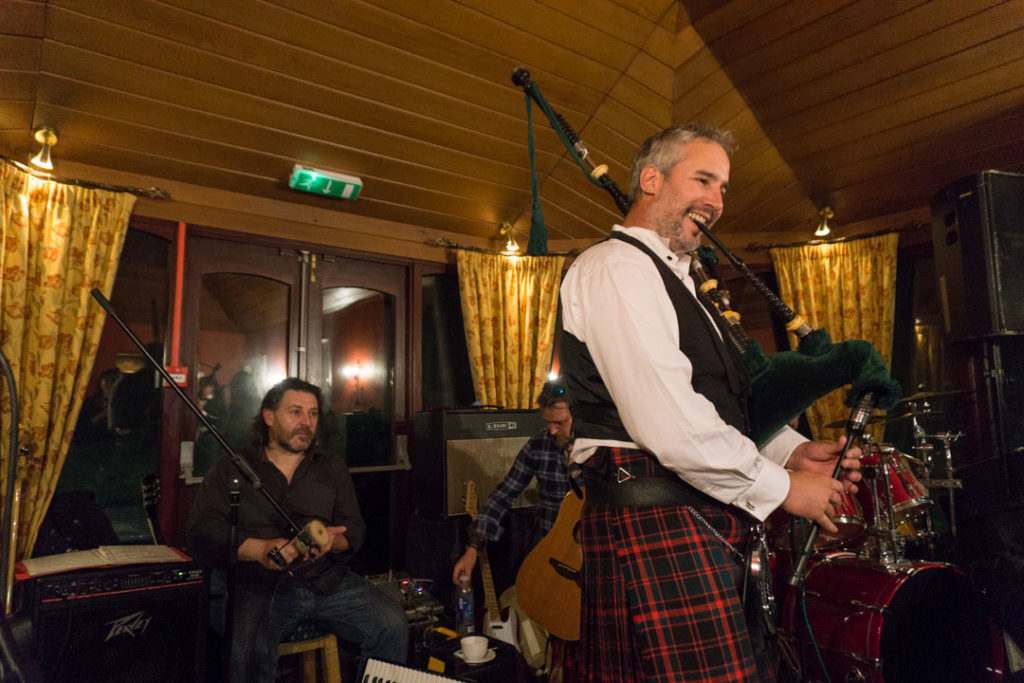
We return to the Spey after lunch, Lawrence escorting us across a bridge and down a path to the next beat. Anglers in Scotland may wear whatever attire they please in most places, especially when loch fishing in inclement weather. But some scrap of tweed is the norm on the Spey.
Lawrence stands behind me in the water, offering pointers as I attempt to master my Spey cast on the opposite side of the river. He estimates that 80 percent of anglers here wear tweed of some fashion.
“We try to keep tradition; hence why we have tweed suits,” he says. “We avoid what you see on some of the beats where they’re all decked out like Scandinavian anglers. I’m not saying that’s a bad thing. I’m not putting Scandinavians down by any means. They’re very good anglers. We just want to keep our name, if you like, keep our name.”
“Am I dressed like a Scandinavian?” I ask, already having a good idea of the answer. Lawrence looks over my fleece jacket and baseball hat as he rolls a cigarette, bits of tobacco flaking to the river, and says, “Well . . . you look like a very contemporary angler.”
We swing away the afternoon, sweeping the rods diligently, intermittently succeeding in unfolding the line and flailing the next, but getting some respectable swings over the salmon. We know they see our flies; they jump out of the water in a territorial protest after a drift overhead. Not even Corin can coax one to bite. It’s a tease to see such a massive fish challenge your fly but refuse to take it. In spite of our lack of salmon, we can’t complain.
“Fly fishing in Scotland isn’t just a caricature of a bygone era. We offer modern fly fishing experiences equivalent to the very best international lodges, while also offering heritage and culture by the truck load,” says Corin. “Most importantly, we can show that it’s possible to run a successful and sustainable rural industry that doesn’t involve ruthlessly exploiting natural resources.”
With dinner approaching, we give up on the Spey, one final fish flashing its russet flank in a farewell leap and plunge. We walk back to the truck upon the grass paths below watchful hills, perhaps taking the same route walked by the King and perhaps making the same promises to ourselves. We’ll be back. After all, we’ve salmon to catch.
